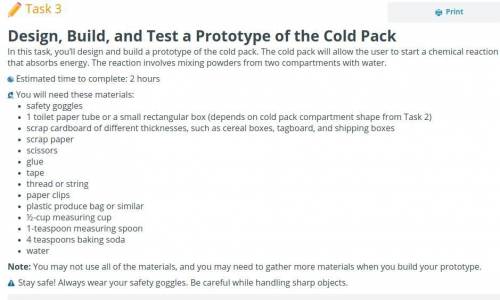UNIT 2:Course Activity: Building a Device that Uses Energy from Chemical Reactions
task 3
Pa...

Physics, 10.12.2020 21:30 khalfani0268
UNIT 2:Course Activity: Building a Device that Uses Energy from Chemical Reactions
task 3
Part A
Identify the problem that the cold pack must address.
Part B
Criteria are the specific goals of the design. List at least two criteria for the design based on the question, What do you want it to do? Keep in mind the design of the cup and what you learned from observing the endothermic chemical reaction.
Part C
Constraints are the limits that we place on a design. Time, materials, or money may be in short supply. Some designs may also be limited by how the product gets used. List at least one constraint on the cold pack design.
Part D
Question
Brainstorm ideas about how to separate the three reactants in the cold pack. Draw your ideas and use text boxes to explain them. Recall the materials list and the layout of your cup from task 2 to help you.
Part E
Question
Create drawings of two fully worked-out ideas for mixing the reactants in the cold pack. Use text boxes to explain your ideas.
Part F
What are the pros and cons of each idea that you explored in part E? How do the ideas compare?
Part G
Select one of your cold pack mixing mechanisms, and use items from the materials list to build a prototype. The prototype doesn’t have to be true to size, but the mechanism for combining the reactants must work. You’ll test the prototype later, so make sure to line the compartment that holds the water with a plastic bag. Describe what you did.
Part H
Test your prototype. Pour ½ cup of water into the compartment that holds the water. Add 2 teaspoons of baking soda to each of the compartments that hold the solid reactants. Test your mechanism for combining the reactants. Did the prototype work? Record the results of your test here. (Note that a chemical reaction will not take place because citric acid isn’t used.)
Part I
Question
Based on the test of your prototype, refine your design and make a final drawing. Use text boxes to label the final design and to note changes that you made.
pls If you got for task 1,2,3 all right send a screen shot PLS


Answers: 1


Another question on Physics

Physics, 22.06.2019 04:00
All the simple machines make work easier to do by changing the or of a force. a. size; type b. work; type c. size; direction d. type; direction
Answers: 2

Physics, 22.06.2019 05:00
Red light strikes a metal surface and electrons are ejected. if violet light is now used with a 10% greater intensity, what will happen to the ejection rate (number of ejected electrons per second) and the maximum energy of the electrons? a) greater ejection rate; same maximum energyb) same ejection rate; greater maximum energyc) greater ejection rate; greater maximum energyd) same ejection rate; same maximum energye) none of the above answers are correct
Answers: 1

Physics, 22.06.2019 12:50
The vapour pressure of benzene is 53.3 kpa at 60.6 °c, but it fell to 51.5 kpa when 19.0 g of a non-volatile organic compound was dissolved in 500 g of benzene. calculate the molar mass of the compound.
Answers: 2

Physics, 22.06.2019 17:50
Two identical stars with mass m orbit around their center of mass. each orbit is circular and has radius r, so that the two stars are always on opposite sides of the circle. (a) find the gravitational force of one star on the other. (b) find the orbital speed of each star and the period of the orbit. (c) how much energy would be required to separate the two stars to infinity?
Answers: 1
You know the right answer?
Questions



Computers and Technology, 31.12.2019 02:31




Social Studies, 31.12.2019 02:31















